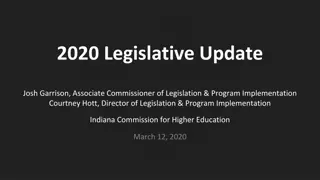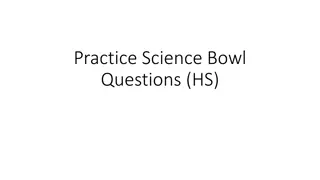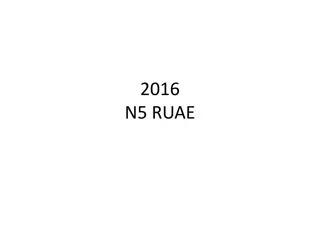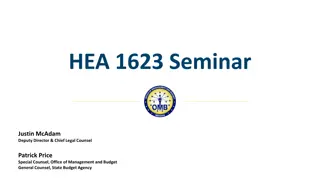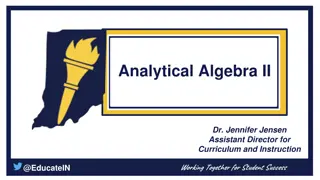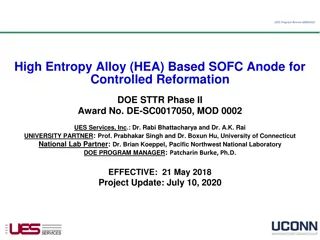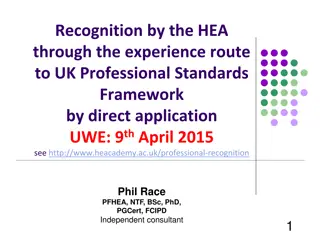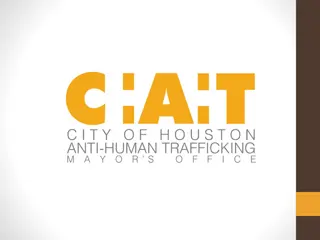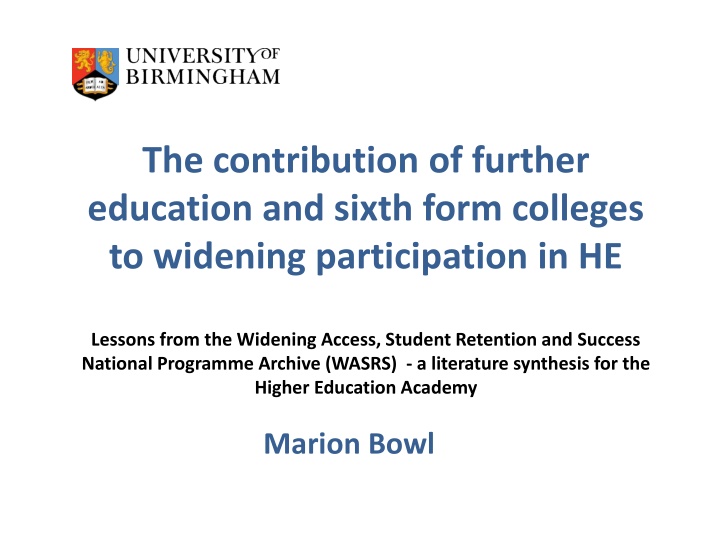
Contribution of Further Education & Sixth Form Colleges to Widening Participation in HE
Explore the valuable contributions of further education and sixth form colleges to widening participation in higher education through lessons from the Widening Access, Student Retention, and Success National Programme Archive. The synthesis delves into themes like formal partnerships, support for progression, targeting under-represented groups, and more to create a comprehensive resource informing policy, practice, and research on student engagement, retention, success, employability, and social mobility.
Download Presentation

Please find below an Image/Link to download the presentation.
The content on the website is provided AS IS for your information and personal use only. It may not be sold, licensed, or shared on other websites without obtaining consent from the author. If you encounter any issues during the download, it is possible that the publisher has removed the file from their server.
You are allowed to download the files provided on this website for personal or commercial use, subject to the condition that they are used lawfully. All files are the property of their respective owners.
The content on the website is provided AS IS for your information and personal use only. It may not be sold, licensed, or shared on other websites without obtaining consent from the author.
E N D
Presentation Transcript
The contribution of further education and sixth form colleges to widening participation in HE Lessons from the Widening Access, Student Retention and Success National Programme Archive (WASRS) - a literature synthesis for the Higher Education Academy Marion Bowl
Outline Description of archive and syntheses Approach to FE synthesis - - - - - Headlines Formal and informal partnerships Support for progression Targeting under-represented groups Curriculum initiatives to aid transition Dual sector institutions Issues raised by the synthesis Possible areas for research?
WASRS National Archive www.heacademy.ac.uk/assets/documents/WPsyntheses/WASRS_Bowl.pdf Brings together literature from five national widening participation programmes operating between 1999 and 2012: - Aimhigher - Aimhigher Associates - Action on Access - Lifelong Learning Networks - What works? Student retention and success
Aims for the synthesis To draw together the central themes running through the archive To create a freely-available research and practice-based resource To inform policy, practice research on: student engagement, retention, success, employability and social mobility
7 synthesis themes The contribution of further education and sixth form colleges to widening participation The role of higher education students in widening access and improving retention Collaboration and partnership working in a competitive environment The contribution of pre-entry interventions to student retention and success Promoting social mobility by creating pathways to the professions and vocational careers: the role of progression agreements Student finance: what have we learned inform access, retention and success under the new funding regime in England? Findings from the final years of the Aimhigher Programme 2008-2011
Further education and sixth form colleges: definition and context Autonomous institutions under the Further and Higher Education Act 1992 Providing a mix of academic and vocational education and training from basic to higher Foundation degrees since 2001 Increasing HE in FE provision in the context of government aim to increase HE participation
Approach Word/phrase search of archive 95 documents identified Categorised by keywords (in Refworks) and annotated Aggregated into themes and sub-themes to structure synthesis relevance scope focus rigour applicability Selection of best evidence 23 documents based on: Reduced to 7 key reports (a requirement of the contract)
Synthesis themes 1. Involvement in formal and informal partnerships 2. Support for progression: awareness raising, information, advice and guidance 3. Targeting under-represented groups 4. Curriculum initiatives to aid transition 5. Higher education in further education colleges
1. Formal and informal partnerships: key points FE rarely a full partner in Aimhigher partnerships Importance of buy in at all levels in college hierarchy The value of informal relationships but the limitations of time and staffing for FE staff Importance of pre-existing, historical relationships Market competition and partnership in tension (esp. where FE is also an HE provider) Sustainability of partnerships post-funding and with intensifying competition Areas for further research? The nature and sustainability of partnerships to widen participation in the context of an educational marketplace The impact of informal FE/HE links on facilitating progression
2. Support for progression: awareness-raising, information, advice and guidance: key points Compared with A level students, vocational learners are disadvantaged because they get less information from their parents teachers, and in case of work-based learners, might even face hostility from their employers. (Hatt and Tate 2009: 28) Tutors play a key role in advising and supporting learners progression decisions. Often learners see tutors as a more important source of support than advice and guidance specialists. (Aimhigher Greater Manchester 2009: 11) While some tutors proactively offer information, advice and guidance, on subject and university choice, others are more reactive, attempting to answer specific learner queries or signposting to sources such as prospectuses and university websites. (Aimhigher Greater Manchester 2009: 11)
2. Support for progression: awareness-raising, information, advice and guidance: key points Evidence that employers unaware/uninterested in progression opportunities for staff Balance between generalist (expert careers advisor) and specialist (industry expert) advice Lack of co-ordination, training and awareness of progression opportunities among subject tutors Lack of tracking from vocational routes to higher level study Limitations of advice from family and friends, especially in rapidly-changing vocational areas Areas for further research? The effectiveness of different models and approaches to IAG for FE learners The impact of changing government policy on IAG in FE Tracking learner progression from FE/vocational routes Employer attitudes to progression
3. Targeting under-represented groups The very learners whom HE needs to recruit have been and still are the traditional clientele of further education colleges. (Hatt and Tate 2009: 8) HEFCE target groups generally not addressed specifically Preference for a whole cohort approach, which assumes relative under-representation of FE learners and eschews singling out of labelled individuals Focus instead on WP in relation to specific subject areas: health, social care, early years, sport and tourism, creative industries, construction, IT and engineering Raises the issue of most under-represented groups especially care leavers Areas for further research? Student/teacher perspectives on targeting Impact of specific targeting initiatives
4. Curriculum initiatives to aid transition Mainly confined to bridging units to smooth transition for vocational learners next level Fundability a key issue for colleges For students, structural constraints appear to outweigh academic concerns Specific gaps identified in FE curriculum: maths for education, science for veterinary sciences Areas for further research? Curricular/pedagogic articulation between FE and HE
5. Dual sector institutions Targeting defined in terms of gender, ethnicity, age lower SEG assumed by the vocational nature of programmes - - - - Seamless progression inhibited by: Different funding regimes between FE and HE within one institution Embedded historical divisions Lack of information on progression from levels 3 to 4 Poor articulation between FE and HE programmes and between foundation programmes and honours top ups Need for bridging modules which raises the question of fit Some universities retaining standard entry requirements which are a barrier, particularly for mature entrants - - Need for progression to be built on pre-existing partnerships Areas for further research? Tracking progression from FE to HE within and between institution types The nature of IAG for FE to HE progression
Summary: Methodological issues Working with grey literature rigour, reliability and validity Gaps in the literature (e.g. access courses, teaching and learning issues, sixth form colleges) Expectations of stakeholders: hidden agendas
Summary: research issues The nature and sustainability of partnerships to widen participation in the context of an educational marketplace The impact of informal FE/HE links on facilitating progression The effectiveness of different models and approaches to IAG for FE and HE in FE students Tracking progression from FE to HE - within and between institution types the social, personal and economic outcomes The impact of changing government policy on IAG in FE Employer attitudes to progression Student/teacher perspectives on targeting Impact of specific targeting initiatives Curricular/pedagogic articulation between FE and HE



